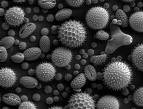Diesel Particulate Matter

What is Diesel Particulate Matter (DPM)?
DPM is part of a complex mixture that makes up diesel exhaust. It is commonly found throughout the environment and is estimated by the United States Environmental Protection Agency’s National Scale Assessment to contribute to human health risk. Diesel exhaust is composed of two parts, either gas or particles and both parts contribute to the risk. The gas is composed of hazardous air pollutants, such as acetaldehyde, acrolein, benzene, 1,3-butadiene, formaldehyde and polycyclic aromatic hydrocarbons. The particles have different types that can be classified by size or composition. The size of diesel particulates that are the greatest health concern are those that are in the categories of fine, and ultra fine particles that may be comprised of elemental carbon, ash, metallic abrasion particles, sulfates, and silicates.
How Do I Get Exposed to DPM and Can it Affect My Health?
The most common exposure pathway is breathing the air that contains the DPM. The fine and ultra fine particles are respirable which means that they can avoid many of the human respiratory system defense mechanisms and enter deep into the lungs. Think about fresh air along with micron sized balls of filth with a miniature throwing star in the center going into your lungs! If the smaller particles go deep enough into the lungs, they can become trapped with the possible result of emphysema, lung disease and/or lung cancer.
What Can I Do to Minimize My Health Risk from DPM?
- Keep your diesel engine well-tuned and maintained
- Perform routine maintenance on all filtering systems and air handlers
- Retrofit diesel engines with pollution control devices such as…
clean-exhaust systems powered by ecoBrew™…the
Green solution to marine diesel pollution!
